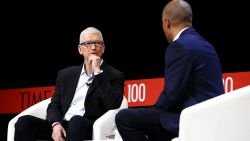Editor’s Note: Arthur Dong is a distinguished teaching professor of strategy & economics at Georgetown’s McDonough School of Business. The opinions expressed in this commentary are his own.

Apple has a China problem. CEO Tim Cook took to the airwaves on Wednesday to announce an earnings miss for the fourth quarter of 2018, which he attributed to a decline in sales in the China market. The slump reflects a broader slowdown of the Chinese economy as the consequences of the ongoing trade dispute between China and the United States begin to manifest.
For careful observers, this should not come as a surprise. China’s fourth quarter 2018 purchasing managers’ index data was at 49.4, a clear signal that China’s economy is slowing — anything below 50 signals a slowing economy and dampened prospects for future growth.
China’s economic vulnerability is based on its very unbalanced growth model. In other advanced economies such as the United States, spending by consumers contributes as much as two-thirds or more of overall GDP. In China, consumption has risen from 35% 10 years ago, but it is still not near 60% of GDP, indicating an unbalanced economy that places emphasis on exports and investment, both of which, in the long run, are not sustainable.
China’s success as an export powerhouse is well understood, as many of the things that American consumers own bear the “made in China” label. Its emphasis on investment-driven growth has come by way of investment in infrastructure, construction, property development, high-speed rail and transit facilities. Investment in infrastructure and heavy construction turbo-boosted China’s economy in 2008 and for the next five years, but it issued a tremendous amount of debt to support such growth. Currently, the debt-to-GDP ratio for China stands at an alarming 250% of GDP, an unsustainable number and one that presents formidable challenge to China’s economic policymakers.
More Markets & Economy Perspectives
As the US-China trade war escalated and the US placed tariffs on over $200 billion dollars of Chinese exports, demand has decreased since these goods are now more expensive in the US market. There are widespread reports that factories are laying off workers and enforcing hiring freezes across China’s industrial landscape. In the manufacturing hub of Guangdong Province, factories have been dismissing workers, telling them to go home early for the Chinese New Year without pay as factory orders from American companies dry up.
As the impact of the US-China trade war begins to filter through the Chinese economy, the Chinese consumer is taking action to prepare for an uncertain future. Consumers are the first to realize the change in fortunes within China’s economy, and are spending less over fear of job loss and depressed wages consumer sentiment.
What’s more, within China, Apple is facing lower-priced competition by the likes of Samsung, Huawei, Xiomi and ZTE. Phones offered by Apple’s Chinese competitors are both packed with features and sell at a fraction of what an iPhone sells for in China.
The ongoing US-China trade war will also impact the broader global economy. The German, South Korean and Japanese economy provide important inputs and supplies to the Chinese manufacturing economy. When Foxconn assembles an iPhone in China, many of the parts that go into the iPhone are imported from South Korea, Japan and Germany. Thus, a slowdown in China will infect other parts of the global economy.
In the months ahead, be prepared to witness continued deterioration of the Chinese economy. This will be reflected in declining asset values such as real estate and equity markets, distressed corporate balance sheets and corporate assets, increased capital flight as a result of a declining Yuan relative to the US dollar, and growing stress within China’s financial sector as non-performing loans accelerate within the banking sector. Given this backdrop, 2019 is going to be a challenging year for the Chinese economy and China’s policymakers as they juggle numerous challenges across multiple dimensions.


















